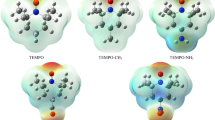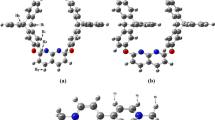Abstract
This study aims to experimentally and theoretically examine the nature and energy of intermolecular bond interactions between thiourea and water molecules using natural bond orbital (NBO), non-linear optical (NLO), atoms in molecules (AIM), and reduced density gradient (RDG) analyses based on the quantum chemical approach and spectroscopic analysis on X-ray and FTIR. Geometry optimizations of Thio-(H2O)1–5 complexes were carried out in the gas phase by B3LYP/6-311++G(d,p) level of density functional theory. The nature of the molecular interactions between the water and thiourea through hydrogen bonding has been investigated using RDG and AIM methods. NBO analysis shows that the Thio-(H2O)5 complex has higher stabilization energy values than the other complexes. The non-linear optical properties, such as dipole moment (μ), the polarizability (α0), and the first hyperpolarizability (βtot), and thermodynamic functions, such as entropy (S), specific heat capacity (Cv), and thermal energy (E), were calculated using the same method. It was observed that thermodynamic parameters, polarizability, and the first hyperpolarizability increased with the number of water molecules. X-ray diffraction analysis confirmed that thiourea is single crystal, and the thiourea/water complexes are crystalline in nature. Besides, the infrared spectrum shows the existence of water molecules and it is used to get details of the structure of the complex.








Similar content being viewed by others
References
Olah GA, Burrichter A, Rasul G, Christe KO, Prakash GS (1997) Preparation, NMR, Raman, and DFT/IGLO/GIAO-MP2 study of mono-and diprotonated thiourea and theoretical investigation of triprotonated thiourea1. J Am Chem Soc 119(19):4345–4352
Hata M, Moribe K, Ando S, Tozuka Y, Yamamoto K (2014) Density functional theory study of equimolar complexation of urea or thiourea with 2-alcoxybenzamide. J Struct Chem 55(8):1506–1513
Martin ML, Filleux-Blanchard ML, Martin GJ, Webb GA (1980) Application of 15N spectroscopy and dynamic NMR to the study of ureas, thioureas and their Lewis acid adducts. Org Magn Reson 13(6):396–402
Ha TK, Puebla C (1994) A theoretical study of conformations and vibrational frequencies in (NH2) 2C = X compounds (X = O, S, and Se). Chem Phys 181(1–2):47–55
Sahu S, Rani Sahoo P, Patel S, Mishra BK (2011) Oxidation of thiourea and substituted thioureas: a review. J Sulfur Chem 32(2):171–197
Klern H, Lux J, Noll D, Reider W, Phillips H (1971) Proc. of the American Power Conference, Illinois Institute of Technology, Chicago, IL, April 20–22. 33:702–709
Knox JA, Smith JA, Stout RF (1974) US Patent №3,730,901. Chem Abstr 81:53183
Dawood KM (2019) Bis-thiourea derivatives and their utility in synthesis of mono-heterocyclic, bis-heterocyclic, and fused heterocyclic systems. J Heterocyclic Chem 56(6):1701–1721
Liav A, Angala SK, Brennan PJ, Jackson M (2008) ND-aldopentofuranosyl-N′-[p-(isoamyloxy) phenyl]-thiourea derivatives: potential anti-TB therapeutic agents. Bioorg Med Chem Lett 18(8):2649–2651
Tsogoeva SB, Hateley MJ, Yalalov DA, Meindl K, Weckbecker C, Huthmacher K (2005) Thiourea-based non-nucleoside inhibitors of HIV reverse transcriptase as bifunctional organocatalysts in the asymmetric Strecker synthesis. Bioorg Med Chem 13(19):5680–5685
Falzon D, Hill G, Pal SN, Suwankesawong W, Jaramillo E (2014) Pharmacovigilance and tuberculosis: applying the lessons of thioacetazone. Bull World Health Organ 92:918–919
Narimani H, Kohzadi H (2014) A practical and convenient method for the synthesis of anesthetic drug thiopental: using thiourea and sodium ethoxide. Iran Chem Commun 2:48–55
Živec M, Anzic B, Gobec S (2010) A novel scalable synthesis of pramipexole. Org Process Res Dev 14(5):1125–1129
Hassan AA, El-Sheref EM (2010) Chemistry and heterocyclization of dithiobiurea and thioureidoalkylthiourea. J Heterocyclic Chem 47(4):764–784
Sharma SK, Steinbergs N, Wu Y, Crowley ML, Hanson AS, Casero Jr RA, Woster PM (2010) (Bis)urea and (Bis)thiourea inhibitors of lysine-specific demethylase 1 as epigenetic modulators. J Med Chem 53(14):5197–5212
Jara P, Merchan J, Yutronic N, Gonzalez G (2000) Macroscopic evidence of inclusion phenomena in urea and thiourea matrices. J Incl Phenom Macrocycl Chem 36(1):99–100
Shakeel A, Altaf AA, Qureshi AM, Badshah A (2016) Thiourea derivatives in drug design and medicinal chemistry: a short review. J Drug Des Med Chem 2(1):10
Weiqun Z, Wen Y, Lihua Q (2005) Structure and stability of thiourea with water, DFT and MP2 calculations. J Mol Struct THEOCHEM 730(1–3):133–141
Pawlowski PM, Okimoto SR, Tao FM (2003) Structure and stability of sulfur trioxide–ammonia clusters with water: implications on atmospheric nucleation and condensation. J Phys Chem A 107(27):5327–5333
Ju XH, Xiao HM (2002) Ab initio study on interactions in difluoroamine clusters from one to four molecules. Propellants Explos Pyrotech 27(6):320–326
Xia QY, Xiao HM, Ju XH, Gong XD (2004) Density functional theory study of the structures and properties of (H2AlN3)n (n = 1–4) clusters. J Phys Chem A 108(14):2780–2786
Willard AP, Chandler D (2014) The molecular structure of the interface between water and a hydrophobic substrate is liquid-vapor like. J Chem Phys 141(18):18C519
Ghosh SR, Debnath B, Jana AD (2020) Water dimer isomers: interaction energies and electronic structure. J Mol Model 26(1):1–9
Hammami F, Ghalla H, Nasr S (2015) Intermolecular hydrogen bonds in urea–water complexes: DFT, NBO, and AIM analysis. Comput Theor Chem 1070:40–47
Kaur D, Khanna S (2014) Hydrogen bonding of formamide, urea, urea monoxide and their thio-analogs with water and homodimers. J Chem Sci 126(6):1815–1829
Ivanov EV, Abrosimov VK (2013) Apparent molar volumes and expansibilities of thiourea, 1,3-dimethylurea, and 1,3-dimethylthiourea in water at temperatures from T=(278.15 to 318.15) K and atmospheric pressure. J Chem Eng Data 58(5):1103–1111
Frisch MJ, Trucks GW, Schlegel HB, Scuseria GE, Robb MA, Cheeseman JR, Scalmani G, Barone V, Mennucci B, Petersson GA, Nakatsuji H, Caricato M, Li X, Hratchian HP, Izmaylov AF, Bloino J, Zheng G, Sonnenberg JL, Hada M, Ehara M, Toyota K, Fukuda R, Hasegawa J, Ishida M, Nakajima T, Honda Y, Kitao O, Nakai H, Vreven T, Montgomery Jr JA, Peralta JE, Ogliaro F, Bearpark M, Heyd JJ, Brothers E, Kudin KN, Staroverov VN, Kobayashi R, Normand J, Raghavachari K, Rendell A, Burant JC, Iyengar SS, Tomasi J, Cossi M, Rega N, Millam NJ, Klene M, Knox JE, Cross JB, Bakken V, Adamo C, Jaramillo J, Gomperts R, Stratmann RE, Yazyev O, Austin AJ, Cammi R, Pomelli C, Ochterski JW, Martin RL, Morokuma K, Zakrzewski VG, Voth GA, Salvador P, Dannenberg JJ, Dapprich S, Daniels AD, Farkas Ö, Foresman JB, Ortiz JV, Cioslowski J, Fox DJ (2009) Gaussian 09, Revision C.01. Gaussian, Inc., Wallingford
GaussView, Guassian, Inc. (Carnergie Office Parck-Building6 Pittsburgh PA 151064 USA), Copyright © 2000-2003 Semichem. Inc.
Becke AD (1993) Becke’s three parameter hybrid method using the LYP correlation functional. J Chem Phys 98:5648–5652
Lee C, Yang W, Parr RG (1988) Development of the Colle-Salvetti correlation-energy formula into a functional of the electron density. Phys Rev B 37(2):785
Lu T, Chen F (2012) Multiwfn: a multifunctional wavefunction analyzer. J Comput Chem 33(5):580–592
Runge E, Gross EK (1984) Density-functional theory for time-dependent systems. Phys Rev Lett 52(12):997
Humphrey W, Dalke A, Schulten K (1996) VMD: visual molecular dynamics. J Mol Graph 14(1):33–38
Jayalakshmi D, Kumar J (2006) Growth and characterization of bis thiourea zinc acetate (BTZA). J Cryst Res Technol 41(1):37–40
Ravi B, Jegatheesan A, Neelakandaprasad B, Sadeeshkumar C, Rajarajan G (2014) Optical and conductivity analysis of thiourea single crystals. Rasayan J Chem 7:287–294
Isakov H, Askarov IR, Usmanov S (2018) FTIR spectroscopic studies of compounds of thiourea-formaldehyde oligomers. Universum: Eng Sci J 12(57) (in Rus)
Larkin P (2017) Infrared and Raman spectroscopy: principles and spectral interpretation. Elsevier
Ajayi TJ, Shapi M (2020) Solvent-free mechanochemical synthesis, hirshfeld surface analysis, crystal structure, spectroscopic characterization and NBO analysis of Bis (ammonium) Bis ((4-methoxyphenyl) phosphonodithioato)-nickel (II) dihydrate with DFT studies. J Mol Struct 1202:127254
Glendening ED, Reed AE, Carpenter JE, Weinhold F (1998) NBO Version 3.1, TCl. University of Wisconsin, Madison
Bader RFW (1990) Atoms in molecules – a quantum theory. Oxford University Press, Oxford
Rozas I, Alkorta I, Elguero J (2000) Behavior of ylides containing N, O, and C atoms as hydrogen bond acceptors. J Am Chem Soc 122(45):11154–11161
Johnson ER, Keinan S, Mori-Sánchez P, Contreras-García J, Cohen AJ, Yang W (2010) Revealing noncovalent interactions. J Am Chem Soc 132(18):6498–6506
Agarwal P, Bee S, Gupta A, Tandon P, Rastogi VK, Mishra S, Rawat P (2014) Quantum chemical study on influence of intermolecular hydrogen bonding on the geometry, the atomic charges and the vibrational dynamics of 2,6-dichlorobenzonitrile. Spectrochim Acta A Mol Biomol Spectrosc 121:464–482
Niu X, Huang Z, Ma L, Shen T, Guo L (2013) Density functional theory, natural bond orbital and quantum theory of atoms in molecule analyses on the hydrogen bonding interactions in tryptophan-water complexes. J Chem Sci 125(4):949–958
Acknowledgments
The devices of the Krasnoyarsk Regional Center of Research Equipment of Federal Research Center “Krasnoyarsk Science Center SB RAS” were used in the work. The authors are grateful to G.N. Bondarenko for obtaining X-ray data and Korolkova I.V. for obtaining FTIR spectra.
Author information
Authors and Affiliations
Corresponding author
Additional information
Publisher’s note
Springer Nature remains neutral with regard to jurisdictional claims in published maps and institutional affiliations.
Rights and permissions
About this article
Cite this article
Akman, F., Issaoui, N. & Kazachenko, A.S. Intermolecular hydrogen bond interactions in the thiourea/water complexes (Thio-(H2O)n) (n = 1, …, 5): X-ray, DFT, NBO, AIM, and RDG analyses. J Mol Model 26, 161 (2020). https://doi.org/10.1007/s00894-020-04423-3
Received:
Accepted:
Published:
DOI: https://doi.org/10.1007/s00894-020-04423-3




